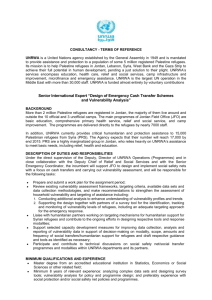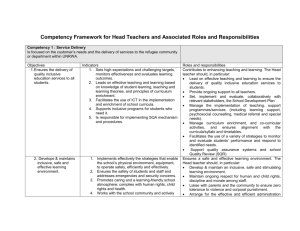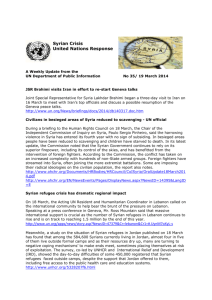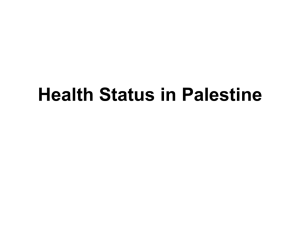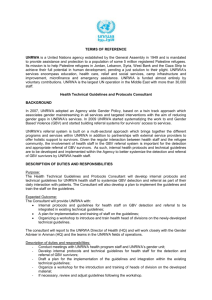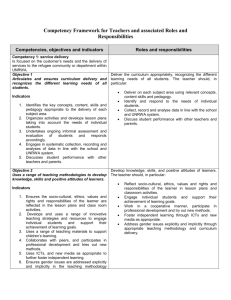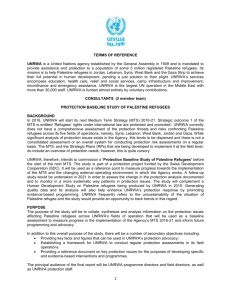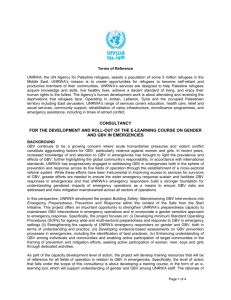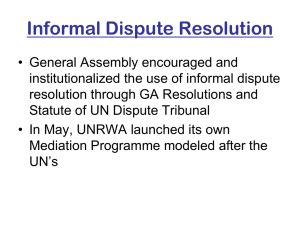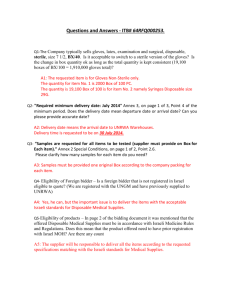MEMORY OF THE WORLD
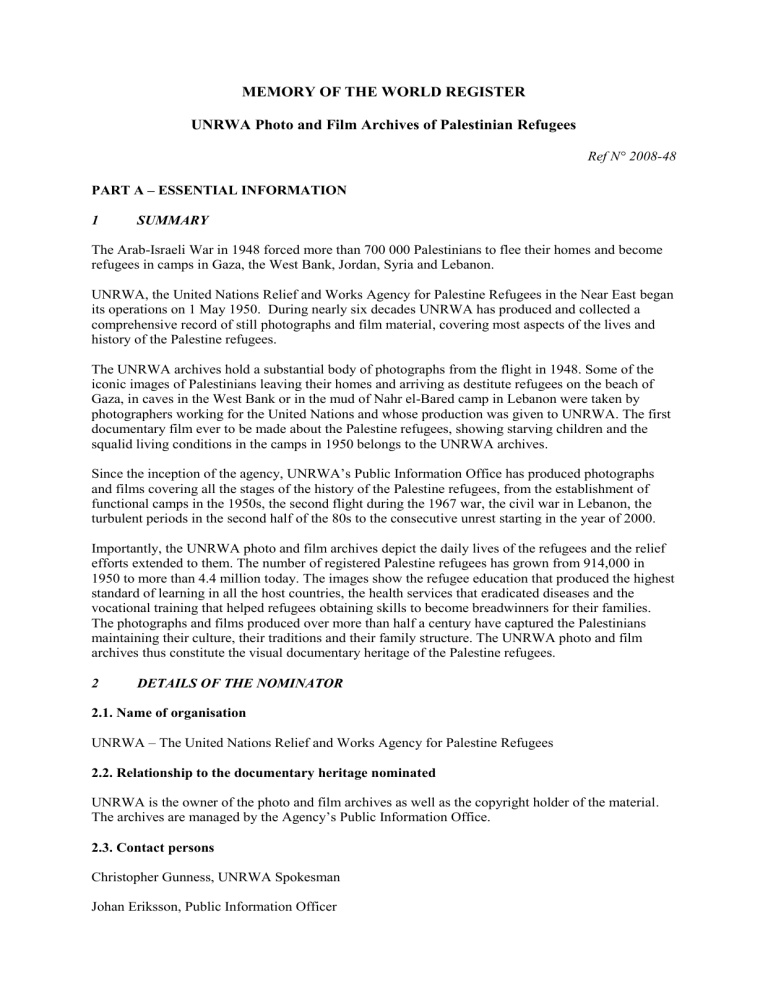
MEMORY OF THE WORLD REGISTER
UNRWA Photo and Film Archives of Palestinian Refugees
Ref N° 2008-48
PART A – ESSENTIAL INFORMATION
1 SUMMARY
The Arab-Israeli War in 1948 forced more than 700 000 Palestinians to flee their homes and become refugees in camps in Gaza, the West Bank, Jordan, Syria and Lebanon.
UNRWA, the United Nations Relief and Works Agency for Palestine Refugees in the Near East began its operations on 1 May 1950. During nearly six decades UNRWA has produced and collected a comprehensive record of still photographs and film material, covering most aspects of the lives and history of the Palestine refugees.
The UNRWA archives hold a substantial body of photographs from the flight in 1948. Some of the iconic images of Palestinians leaving their homes and arriving as destitute refugees on the beach of
Gaza, in caves in the West Bank or in the mud of Nahr el-Bared camp in Lebanon were taken by photographers working for the United Nations and whose production was given to UNRWA. The first documentary film ever to be made about the Palestine refugees, showing starving children and the squalid living conditions in the camps in 1950 belongs to the UNRWA archives.
Since the inception of the agency, UNRWA’s Public Information Office has produced photographs and films covering all the stages of the history of the Palestine refugees, from the establishment of functional camps in the 1950s, the second flight during the 1967 war, the civil war in Lebanon, the turbulent periods in the second half of the 80s to the consecutive unrest starting in the year of 2000.
Importantly, the UNRWA photo and film archives depict the daily lives of the refugees and the relief efforts extended to them. The number of registered Palestine refugees has grown from 914,000 in
1950 to more than 4.4 million today. The images show the refugee education that produced the highest standard of learning in all the host countries, the health services that eradicated diseases and the vocational training that helped refugees obtaining skills to become breadwinners for their families.
The photographs and films produced over more than half a century have captured the Palestinians maintaining their culture, their traditions and their family structure. The UNRWA photo and film archives thus constitute the visual documentary heritage of the Palestine refugees.
2 DETAILS OF THE NOMINATOR
2.1. Name of organisation
UNRWA – The United Nations Relief and Works Agency for Palestine Refugees
2.2. Relationship to the documentary heritage nominated
UNRWA is the owner of the photo and film archives as well as the copyright holder of the material.
The archives are managed by the Agency’s Public Information Office.
2.3. Contact persons
Christopher Gunness, UNRWA Spokesman
Johan Eriksson, Public Information Officer
Amani Shaltout, Photo Librarian
Adnan Abu-Hasna, Media Adviser
2.4. Contact details
Christopher Gunness, UNRWA Spokesman
UNRWA Headquarters, Jerusalem
Zalman Sharagi Street 21
P.O.Box 19149
Zip Code 97200
Jerusalem
Israel
Telephone: +972-542402659
Fax: +972-2-5890274 c.gunness@unrwa.org
Johan Eriksson, Public Information Officer
UNRWA Headquarters, Jerusalem
Zalman Sharagi Street 21
P.O.Box 19149
Zip Code 97200
Jerusalem
Israel
Telephone: +972-542402632
Fax: +972-2-5890274 j.eriksson@unrwa.org
Amani Shaltout, Photo Librarian
UNRWA Headquarters, Gaza
Telephone: +972-8-6777532
Fax: +972-8-6777697 a.shaltout@unrwa.org
Adnan Abu-Hasna, Media Adviser
UNRWA Headquarters, Gaza
Telephone: +972-8-677531
Fax: +972-8-6777697 a.abu-hasna@unrwa.org
3 IDENTITY AND DESCRIPTION OF THE DOCUMENTARY HERITAGE
3.1
Name and identification details of the items being nominated
The UNRWA photo archives contain a selection of around 10 000 photographs, 15 000 colour slides and an estimated 400 000 negatives with corresponding contact sheets from 1948 up to this date.
The UNRWA film archives contain 75 films produced between 1950 and 1984, as well as around 400 videotapes with UNRWA productions and archive material covering a period from the mid 70s to the late 90s.
3.2
Description
3.2.1.
Context .
Since its inception on 1 May 1950 UNRWA started to produce photographic and film material of the
Palestine refugees that had been registered with the Agency and lived inside or outside the camps in the five fields of UNRWA operations, that is Gaza, the West Bank, Jordan, Syria and Lebanon. Beside the film and photographic work done by the staff of the agency, outside contractors contributed with material that became part of UNRWA’s collections. The Palestine refugees were largely ignored by the world’s mainstream media in the aftermath of the 1948 Arab-Israeli war. UNRWA has over time created one of the most comprehensive visual archives that cover the history of the Palestine refugees from the very beginning.
3.2.2. Description of the collection.
3.2.2.1
. The photo archive at UNRWA Headquarters in Gaza is a selection of more than 10 000 black
& white as well as colour images and their negatives, covering a period from 1948 up to this date. It also contains around 15 000 colour slides. The Gaza photo archive is operated by a full time librarian and it holds some of the historically most valuable images of the Palestine refugees.
Thousands of UNRWA photos are sent out annually to requesting parties. UNRWA photos, both as prints and in digital form, are used by newspapers and magazines all over the world, by film and TV producers, by authors and by researchers.
G
W
J
S
The Gaza photo archive is divided into three sections:
1. Prints of black & white and color photos. 2. Slides.3. Negatives. The older black & white photos are more in demand as they are seen by clients as having a higher documentary value. A difficulty with the color slides is that they cannot be duplicated or printed easily given the current technical resources in the Gaza archive. The negatives section is considered the most valuable part of the Gaza archive.
Each picture selected for the archive has a negative which is cut out from the film and kept in a transparent envelope.
The numbering system of the printed photos in the Gaza archive has the following main categories:
1.
Subject or activity
2.
Countries
3.
Camp name
4.
Serial number of image
Each activity and country is symbolized by a letter.
Countries are designated as follows:
Gaza
West Bank
Jordan
Syria
G
I
S
T
L Lebanon
Subjects or activities are designated as follows:
R
E
D
Refugee Conditions
Exodus
Destruction
Geographical
Income Generations (microfinance)
Schools
Training
Portraits P
K
J
Kindergarten
Jobs
M
A
B
C
Massacre
Art (refugee paintings and handicraft)
Blind/Disabled
Clothing
Example of a code for an image: HJ/Baqa’a/10
H Health
J Jordan
Baqa’a Baqa’a camp
10 serial number of image
3.2.2.2
. An estimated 400 000 negatives with corresponding contact sheets are in a cold store at
UNRWA Headquarters in Amman. Every search in recent years into the Amman stock of negatives has resulted in finding previously unseen photographs that have become prominent items in exhibitions, publications, as used on the UNRWA website and published by media. There is an obvious need to conduct an extensive search through the negatives in Amman, classify them and add them to the Gaza library ( see attached proposal for UNRWA Photo and Film Digitization ).
3.2.2.3
. The UNRWA film archive in the cold store at UNRWA Headquarters in Amman contains 75 films that were made from the 50s to the mid 80s on 16 mm and 35 mm film; some of them are produced in different languages. Each film exists in several copies. The UNRWA film archive at
UNRWA Headquarters in Amman also contains around 60 hours of rushes correlating to the finished films ( see attached inventory report of PIO Cold Store at Amman HQ March 2007 ).
Among the titles in the Amman archive is the film “Sands of Sorrow”, the first documentary ever to be made about the Palestine refugees. It was shot in 1950 in Gaza, Jerusalem, and the West Bank and
Jordan and shows images the world had not properly seen at the time, of the plight of the refugees in the newly established camps. The Amman archives also hold some landmark footage from the refugee crisis triggered by the 1967 war. Worth mentioning is the film “Aftermath” that not only captures the flight of the refugees in June 1967 but also follows the events into the following year that saw other, often forgotten conflicts on the East Bank of the River Jordan which forced the refugees to flee again.
These and other films constitute a source of archive material that has become invaluable for contemporary film and TV program makers. Only a fraction of the film archive in Amman has been digitized and UNRWA is looking for funding to preserve these old rolls of film through digitization
( see attached proposal for UNRWA Photo and Film Digitization ).
3.2.2.4
. The video archive in UNRWA Headquarters Gaza contains around 400 U-matic and SP
BetaCam videotapes with finished UNRWA productions as well as rushes and archive material from the 80s and 90s. The Gaza archive also contains productions and archive material originally shot on film in the 50s and 60s that has been transferred to six hours of SP BetaCam tape ( see attached inventory report of PIO Studio Gaza ).
3.3.
Summary of provenance.
These collections of film and photographic material are the result of the work done by in-house
UNRWA photographers and filmmakers at the Agency’s Public Information Office, as well as by outside photographers and film crews commissioned by UNRWA or United Nations Headquarters in
New York. The photos from 1948 and the period leading up to the establishment of UNRWA in 1950 were taken by photographers who worked for other UN agencies. The rights of these photos were transferred to UNRWA.
3.4. History of the UNRWA photographic and film archives
UNRWA began its operations on 1 May 1950. The first collection of visual material was assembled in the Agency’s headquarters in Beirut. The archives started to be built there as the public information
efforts got under way. In 1982 UNRWA’s headquarter was moved to Vienna because of the civil war in Lebanon. During the Vienna period UNRWA’s public information department grew to its biggest size in the history of the agency. It employed several photographers and had an entire film division.
These staff members where based in Vienna and travelled frequently on assignments to UNRWA’s five fields of operations: Gaza, the West Bank, Jordan, Syria and Lebanon. A substantial part of the material in the UNRWA visual archives was created during these years. When UNRWA’s
Headquarters was moved to Gaza in 1996, the photo archive, as it had been organised in Vienna, was moved to its current location in UNRWA’s main building in Gaza. The Public Information Office with its film department followed the Front Office and the Commissioner-General to Gaza. UNRWA also moved some of its divisions to Amman. The film archive was relocated from Vienna to the current cold store at the UNRWA offices in Amman.
3.5. Assessment of physical condition.
3.5.1. The photo library at UNRWA Gaza Headquarters is situated in premises that offer acceptable conditions. The temperature is controlled by an air conditioning system. The photographs, negatives and colour slides are stored in iron cabinets and well organised in folders. However, the library needs to be digitized in order to survive in the long term.
3.5.2. The estimated 400 000 negatives in the cold store at UNRWA Headquarters in Amman are in need of expert intervention to survive the passage of time ( see attached proposal for UNRWA Photo and Film Digitization ).
3.5.3. The archive with cans of 16 mm and 35 mm film in the cold store at UNRWA Headquarters in
Amman should be digitized in the near future. The temperature in the cold store is suitable for film but the old footage must eventually be saved onto digital tape ( see attached proposal for UNRWA Photo and Film Digitization ).
3.5.4. The UNRWA films and productions on analogue U-matic and SP-BetaCam tapes in the film archives in Amman and in the Public Information studio in Gaza should also be transferred to digital format as many of the tapes are more than 20 years old ( see attached proposal for UNRWA Photo and
Film Digitization ).
4 JUSTIFICATION FOR INCLUSION/ ASSESSMENT AGAINST CRITERIA
4.1.
Authenticity
There can be no doubt that the photographs and the filmed material of the various stages of the history of the Palestine refugees are authentic. A substantial part of the photographs have captions indicating the time and the place where they were taken. Most of the films have a commentary that tells where and when the footage was shot. However, for some parts of the material it is difficult to exactly establish the date and place where they were filmed or photographed or the identity of the persons they show. The material in the archives has been produced by UNRWA staff or other UN staff, or by photographers commissioned by UNRWA or other UN organisations. The photo archives at UNRWA
Headquarters in Gaza are to its structure largely a product of the work of the public information staff from the Vienna period. The film material currently stored in Amman is largely produced by the
UNRWA film crews that were dispatched from Beirut between 1950 and 1982. A number of longer productions were shot on film by UNRWA crews coming from Vienna during the first half of the 80s.
The video material was created during the Vienna period as well as during the time from 1996 and onwards when the UNRWA film division was located in Gaza. UNRWA has always exercised extreme caution with images if the date and place where they were taken can not be satisfactorily verified.
4.2. World significance, uniqueness and irreplaceability
World significance:
The Palestine refugee question has had an impact on world politics for six decades. For many years the general public outside the Arab world had very little knowledge of the lives of the Palestine refugees.
UNRWA has collected a visual archive of the Palestine refugees throughout their history in their everyday lives as they have tried to cope with conflicts that have surrounded them. It would be of utmost importance that this visual documentary heritage is preserved.
Uniqueness and irreplaceability:
The Middle East has been marred by wars and unrest for most of the 20 th century and the hostilities continue in the present century. The world media has largely focused on the bloodshed in its reporting from this region. The images and visual testimonies that UNRWA has collected and produced since
1948 offer a unique look at the Palestine refugees as it delves into the very basics of life. The
UNRWA archives are unique as they depict the refugees intimately in their most difficult moments but also when most other cameras have been pointed elsewhere. Without the UNRWA archives the
Palestine refugees would be deprived of their visual heritage.
Criteria of (a) time (b) place (c) people (d) subject and theme (e) form and style
Time:
No other collection covers the Palestine refugees from the very beginning of their journey until this day.
Place:
The images and films in the UNRWA archives have been produced not only in well known places such as Gaza, Jerusalem, the West Bank and Lebanon, but also in the isolated and forgotten refugee camps in Syria. The material contains images and footage from the often neglected suffering of the refugees in the harsh winter of 1967-68 when they had to flee a second time as the Jordan Valley had become a battle zone again.
People:
The archives show the Palestine refugees as they looked like in their traditional clothes when they fled their homes back in 1948, through the modern fashions sported by young women and men who came from the West Bank in 1967 and the increasingly conservative dress code among Palestinian women of today. As a contrast to this, the images of the refugee camps are strikingly similar throughout the decades, conveying an impression of time standing still.
Subject and theme:
UNRWA, with its role as the main provider of humanitarian relief to the Palestine refugees, has been deeply involved in helping them create sustainable lives. The images offer a unique opportunity for the viewer to identify with the refugees on a human level.
Form:
The archives are already an invaluable resource for writers, journalists and film and TV producers who want to go beyond the mainstream reporting. This value could be drastically increased if UNRWA gets the opportunity to fully digitalize the archives.
4.4.
Issues of rarity, integrity, threat and management
Rarity:
5
The UNRWA visual archives hold both the well known, iconic images of the defining moments for the Palestine refugees, as well as previously unseen material that will contribute to a fuller understanding of the history of this region. As pointed out before, 35 mm copies of high standard of the first ever documentary made about the refugees belong to the archives.
Integrity:
About ten cans containing the old 16 mm films in the cold store in Amman are either so frail or heavily spliced that its would prove difficult to run them through a telecine machine in order to digitize them. Among the estimated 400 000 negatives in the cold store in Amman a few thousands are so clogged together that it seems unlikely that even treatment with special emulsions would separate them.
Threat:
Although the film rolls sit in a cold store with a powerful air conditioning system they need to be digitized in the foreseeable future to be preserved.
Management plan:
This is contained in the attachment Proposal for UNRWA Photo and Film Digitization.
UNRWA is looking for funding to embark on this project.
LEGAL INFORMATION
5.1. Owner of the documentary heritage
UNRWA –
The United Nations Relief and Works Agency for Palestine Refugees in the Near East
Public Information Office
Headquarters, Jerusalem
5.3 Legal status:
(a) Category of ownership
Property of UNRWA
(b) Accessibility
The UNRWA photo archive in Gaza is available for outside parties to order printed copies and electronic scans. The rules are established in a release form. The users are charged a nominal fee.
There is a charge of 50 US$ for each UNRWA photo used in a publication. All images used for publication must show the UNRWA photo credit line.
Only a fraction of the films in the archive in Amman have been digitized. They have been made available to broadcasters against a nominal fee.
(c) Copyright status
UNRWA owns the copyright on all the items in the archives.
(d) Responsible administration
The Public Information Office at UNRWA Headquarters is responsible for the administration of the archives.
6 MANAGEMENT PLAN
6.1
Is there a management plan in existence for this documentary heritage? YES
See attachment Proposal for UNRWA Photo and Film Digitization.
7 CONSULTATION
7.1 Provide details of consultation about this nomination with (a) the owner of the heritage
UNRWA
Public Information Office
Headquarters Jerusalem
UNRWA Headquarters, Jerusalem
Zalman Sharagi Street 21
P.O.Box 19149
Zip Code 97200
Jerusalem
Israel
Telephone: +972-2-5890224
Fax: +972-2-5890274
PART B – SUBSIDIARY INFORMATION
8 ASSESSMENT OF RISK
According to assessments conducted by Public Information Office staff in the past year the film material and the negatives in the cold store in Amman are suitable for preservation
9 ASSESSMENT OF PRESERVATION
During the assessments of the film archive in Amman it was established that about ten cans contained film too frail or heavily spliced to be telecined.
PART C - LODGEMENT
This nomination is lodged by:
(Please print name) Johan Eriksson……………………………………………
(Signature)………………………………… (Date) ………………
